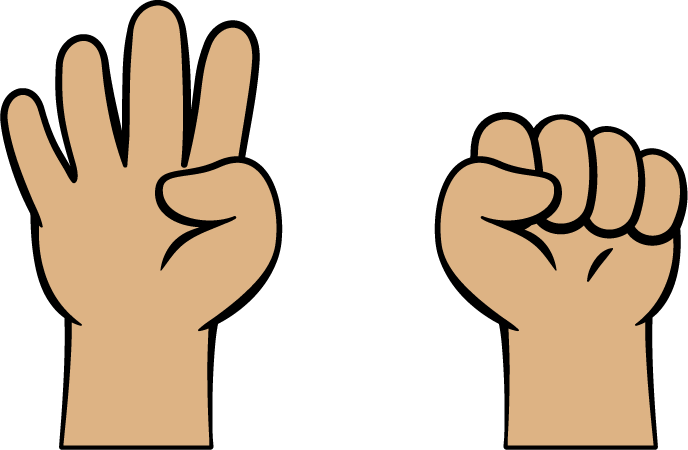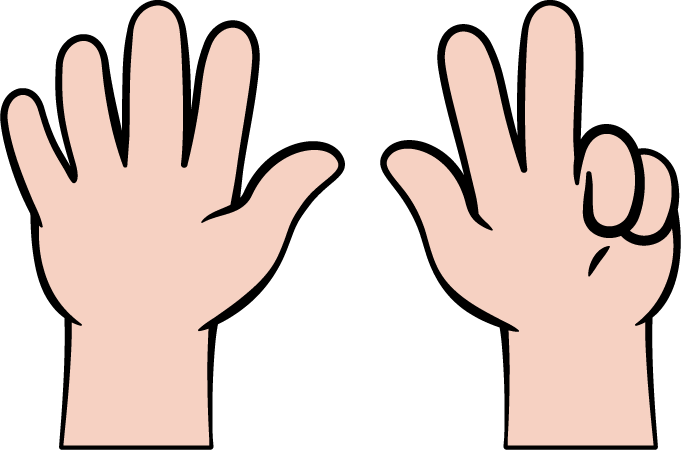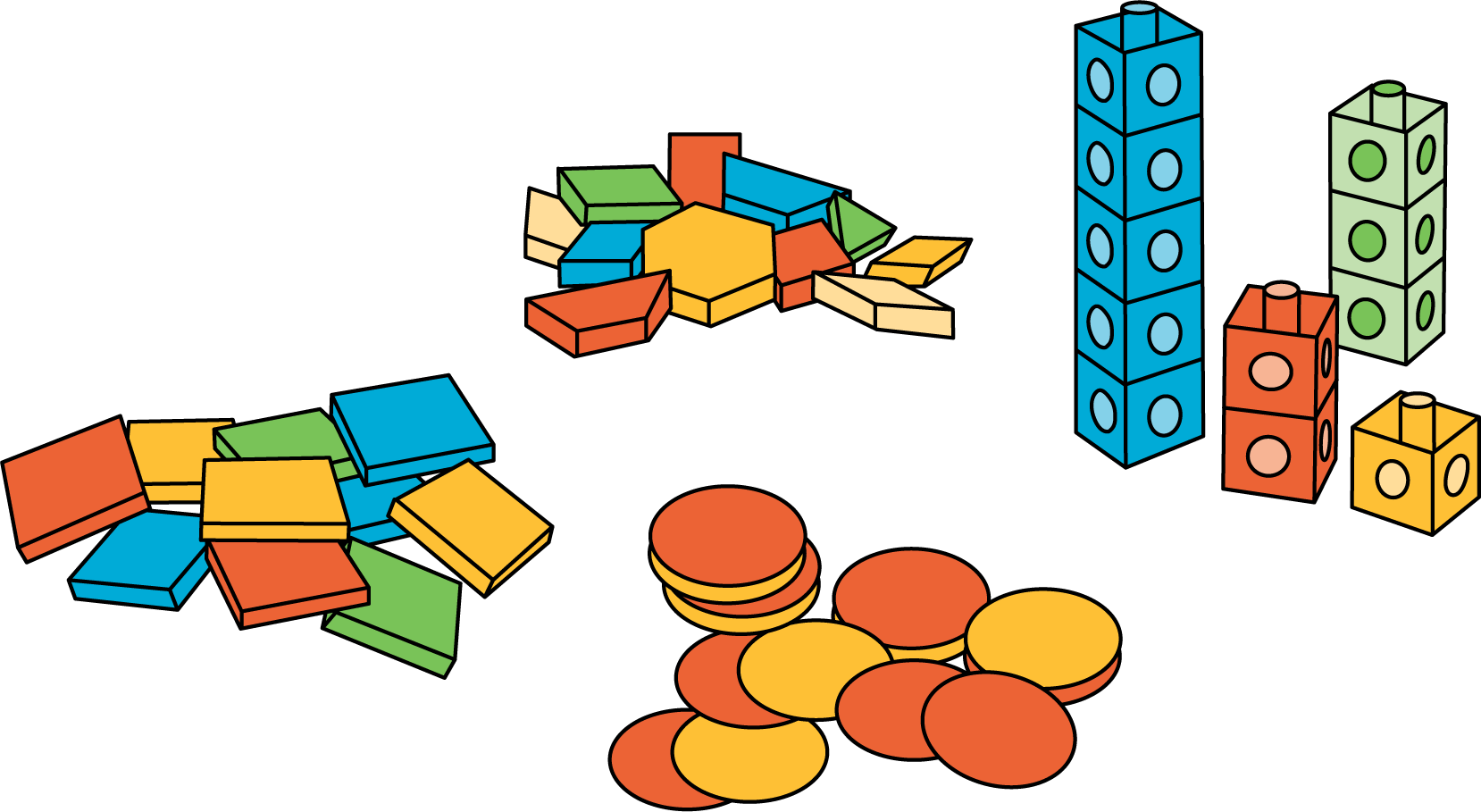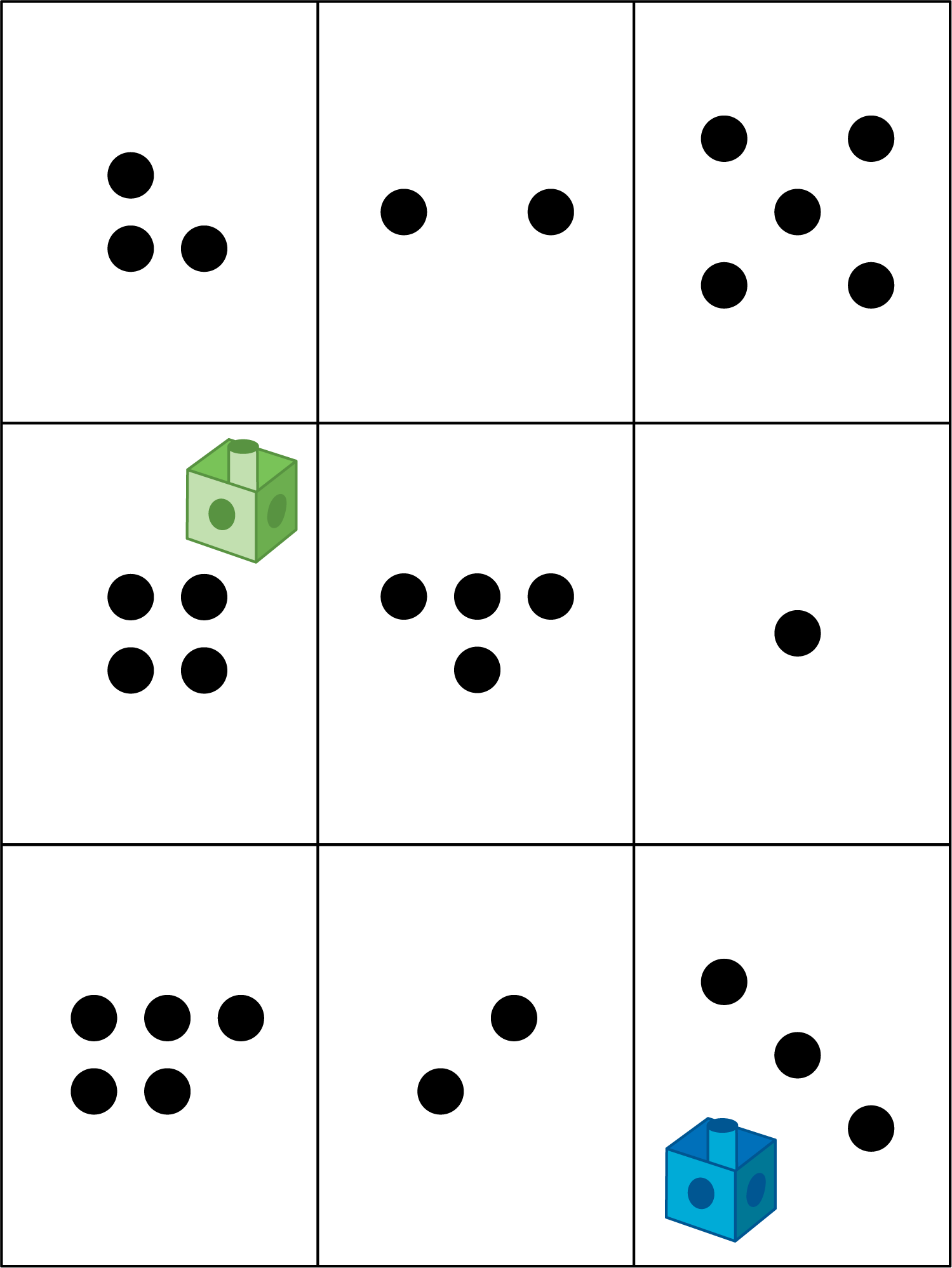Lesson 13
Make 10
Warm-up: How Many Do You See: Fingers Up and Down (10 minutes)
Narrative
The purpose of this How Many Do You See is for students to subitize or use grouping strategies to describe the images they see. When students think about quantities in relation to 5 and 10, they look for and make use of structure (MP7).
Launch
- Groups of 2
- “How many do you see? How do you see them?”
- Flash image.
- 30 seconds: quiet think time
Activity
- Display image.
- “Discuss your thinking with your partner.”
- 1 minute: partner discussion
- Record responses.
- Repeat for each image.
Student Facing
How many do you see?
How do you see them?



Student Response
For access, consult one of our IM Certified Partners.
Activity Synthesis
- Display the hands showing 8 fingers.
- “How many fingers are up?” (8)
- “How many fingers need to go up so there are 10 fingers?” (2)
- Repeat the steps with the rest of the images.
Activity 1: Introduce Math Fingers, Make 10 (10 minutes)
Narrative
The purpose of this activity is for students to learn stage 4 of the Math Fingers center. Students work in partners to show a number on their fingers and determine how many fingers are needed to make 10. Students fill in an equation to represent each composition and decomposition of 10.
Advances: Listening, Representing
Required Materials
Materials to Gather
Materials to Copy
- Number Mat 1–9
- Math Fingers Stage 4 Recording Sheet
Launch
- Groups of 2
- Give each group of students a connecting cube, a number mat, and a recording sheet.
- “We are going to learn a new way to do the Math Fingers center. It is called Math Fingers, Make 10.”
- Display and roll a connecting cube onto the number mat.
- “I rolled 7, so I am going to hold up 7 fingers.”
- “Now my partner needs to figure out how many more fingers I need to put up to show 10 fingers. How many more fingers do I need to hold up to make 10?” (3.)
- 30 seconds: quiet think time
- Share responses.
- Display the recording sheet.
- “Now we need to fill in an equation to show how many fingers are up and how many more fingers are needed to make 10. How should I fill in an equation?” (\(7 + 3\))
- 30 seconds: quiet think time
- Share responses.
- “Take turns with your partner rolling to find a number and showing that number with your fingers. Your partner figures out how many more fingers are needed to make 10. You both fill in an equation to show how many fingers are up and how many more fingers are needed to make 10.”
Activity
- 7 minutes: partner work time
Activity Synthesis
- “If Lin holds up 8 fingers, how many more fingers does she need to hold up to make 10? How do you know?” (2 fingers. I held up 8 fingers and counted 2 fingers that are down. I know that 8 and 2 make 10.)
Activity 2: Make 10 (15 minutes)
Narrative
The purpose of this activity is for students to determine how many are needed to make 10 when added to a given number. Students may use 10-frames or fingers to help them make 10. As students choose how to determine how many are needed to make 10, they use appropriate tools strategically (MP5). Students fill in equations to show each way to compose and decompose 10. The purpose of the activity synthesis is to highlight different strategies students use based on the given number. These may include:
- using a 10-frame
- using fingers
- “just knowing” for numbers like 5 and 9
10-Frames are provided as a blackline master. Students will continue to use these throughout the year. Consider copying them on cardstock or laminating them and keeping them organized to be used repeatedly.
Supports accessibility for: Social-Emotional Functioning, Attention
Required Materials
Launch
- Groups of 2
- Give students access to two-color counters and 10-frames.
- “Work with your partner to figure out which number you need to make 10 with each number. Once you both agree, write a number on the line. Then fill in an equation to show the parts to make 10.”
Activity
- 10 minutes: partner work time
- Monitor for students who use a 10-frame and counters or fingers.
Student Facing
3
_______________
\(10 = \underline{\hspace{1 cm}} + \underline{\hspace{1 cm}}\)
9
_______________
\(10 = \underline{\hspace{1 cm}} + \underline{\hspace{1 cm}}\)
2
_______________
\(10 = \underline{\hspace{1 cm}} + \underline{\hspace{1 cm}}\)
5
_______________
\(10 = \underline{\hspace{1 cm}} + \underline{\hspace{1 cm}}\)
7
_______________
\(10 = \underline{\hspace{1 cm}} + \underline{\hspace{1 cm}}\)
6
_______________
\(10 = \underline{\hspace{1 cm}} + \underline{\hspace{1 cm}}\)
8
_______________
\(10 = \underline{\hspace{1 cm}} + \underline{\hspace{1 cm}}\)
4
_______________
\(10 = \underline{\hspace{1 cm}} + \underline{\hspace{1 cm}}\)
Student Response
For access, consult one of our IM Certified Partners.
Advancing Student Thinking
- “What are you trying to figure out?”
- “How can a 10-frame or your fingers help you figure out what number you need to make 10?”
Activity Synthesis
- Invite a student who used a 10-frame and counters to share how they figured out how to make 10 with 2.
- “What are the 2 parts that they used to make 10?” (2 and 8.)
- Invite a student who used fingers to share how they figured out how to make 10 with 6.
- “What equation should they write? How do you know?” (They should write \(10 = 6 + 4\) because 6 and 4 go together to make 10.)
- “Were there any numbers that you just knew how many more you needed to make 10?” (I knew that 5 and 5 is 10. I knew that if there are 9, you only need 1 more to make 10.)
Activity 3: Centers: Choice Time (15 minutes)
Narrative
The purpose of this activity is for students to choose from activities that offer practice with counting, adding, composing, and decomposing numbers.
Students choose from any stage of previously introduced centers.
- Math Fingers
- Shake and Spill
- Counting Collections
- Roll and Add
Required Materials
Materials to Gather
Required Preparation
- Gather materials from:
- Math Fingers, Stages 1-4
- Shake and Spill, Stages 1-3
- Counting Collections, Stage 1
- Roll and Add, Stages 1 and 2
Launch
- “Today we are going to choose from centers we have already learned. You can also keep playing Math Fingers.”
- Display the center choices in the student book.
- “Think about what you would like to do first.”
- 30 seconds: quiet think time
Activity
- Invite students to work at the center of their choice.
- 8 minutes: center work time
- “Choose what you would like to do next.”
- 8 minutes: center work time
Student Facing
Choose a center.
Math Fingers

Shake and Spill

Counting Collections

Roll and Add

Activity Synthesis
- Write \(10 = 1 + 9\)
- “This is the equation that Clare wrote. What did Clare’s fingers look like? How do you know?” (She held up 1 finger. She figured out that she needed 1 more finger to make 10.)
Lesson Synthesis
Lesson Synthesis
“Why are our fingers a helpful tool if we want to find different ways to make 10?” (We have 10 fingers. We can show different numbers on our fingers. We can put some fingers up and figure out how many fingers are still down.)
Write 3.
“Show your partner how you can use your fingers to figure out what number goes with 3 to make 10.”
Write \(10 = 3 + 7\)
“10 is 3 plus 7. 3 and 7 are 2 parts that go together to make 10.”
Cool-down: Make 10 (5 minutes)
Cool-Down
For access, consult one of our IM Certified Partners.